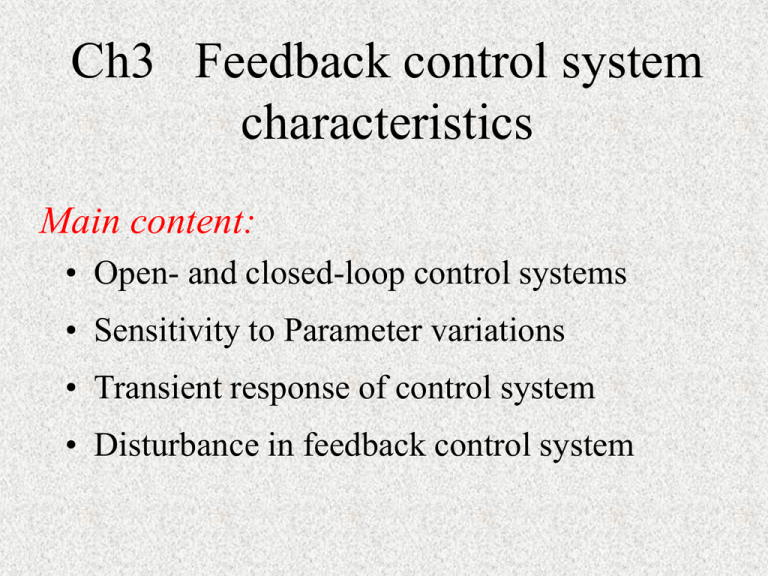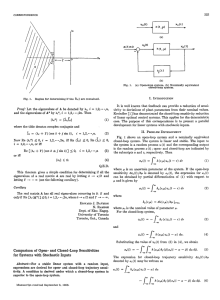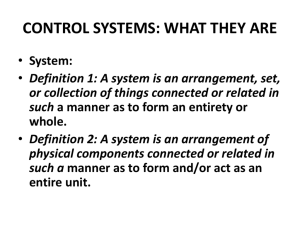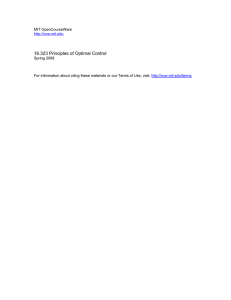Ch3 Feedback control system characteristics Main content:
advertisement

Ch3 Feedback control system characteristics Main content: • Open- and closed-loop control systems • Sensitivity to Parameter variations • Transient response of control system • Disturbance in feedback control system continue Main content: • Steady-state error • The cost of feedback • Examples and simulation 3.1 Open-loop and closed-loop control systems • Review the concepts and structure • Refer to P174-175 The roles of feedback Benefits: • Reduce error (eliminating the error) • Reduce sensitivity or Enhance robustness • Disturbance rejection or elimination • Improve dynamic performance or adjust the transient response (such as reduce time constant) 3.2 Sensitivity of system to parameter variations System are time-varying in its nature because of inevitable uncertainties such as changing environment , aging , and other factors that affect a control process.All these uncertainties in open-loop system will result in inaccurate output or low performance. However, a closedloop system can overcome this disadvantage. Continue A primary advantage of a closed-loop feedback control system is its ability to reduce the system’s sensitivity to parameter variation. Sensitivity analysis Robust control Effect of parameter variations If process G (s ) is change as G ( s) G ( s) • Open-loop system Y ( s) G ( s) R( s) • Closed-loop system G ( s) Y ( s) R( s ) (1 GH )(1 GH GH ) G ( s) R( s ) 2 (1 GH ) continue In the limit, for small incremental changes, last formula is T ( s) / T ( s) InT S G ( s) / G ( s) InG Sensitivity comparison • Open-loop system S 1 T G • Closed-loop system 1 S 1 G( s) H ( s) T G Sensitivity to parameters If system TF is N ( s, ) T ( s, ) D ( s, ) System sensitivity to is InT InN InD N D S S S In In In T Example of sensitivity • Feedback amplifier Refer to 178-179 • Goal: Reduce the sensitivity to parameters variation, that is enhance the robustness to change in amplifier gain. 3.3 Transient response of system • Transient response is the response of a system as a function of time. It is one of the most important characteristics of control system. • If transient response is not satisfying, what shall we do? Control of transient response (Take speed control system as example) • Cascade controller Refer to P180 (Figure 4.6 and Figure 4.7) • Feedback controller Refer to P181 (Figure 4.8) 3.4 Disturbance in a feedback control system • Disturbance signal is an unwanted extraneous input signal that affects the system’s output signal, such as noise for amplifier,wind gusts for radar antennas,etc. • Feedback control can completely or partially eliminate the effect of disturbance signal. Example of steel rolling mill • Refer to P183-187 • Load changes or disturbances+Noise • Feedback can alleviate the effects of disturbances and noise signal occurring within the feedback loop. • If system exists noise at the input point, we can design a low-pass filter to improve SNR (signal-noise ratio) System sensitivity System sensitivity is defined as the ratio of the percentage change in the system transfer function to the percentage change of the process transfer function. It is defined as T ( s) / T ( s) S G( s) / G( s) 3.5 Steady-state error • Steady-state error is the error after the transient response has decayed,leaving only the continuous response. • Feedback can reduce the steady-state error of control system How to define the error ? • From input point: E a (s)=R(s)-H(s)Y(s) • From output point: E (s)=R(s)-Y(s) Only for unit feedback H(s)=1,We have E a (s)= E (s) Comparison of error • Open-loop system Eo ( s) R( s) Y ( s) (1 G( s)) R( s) • Closed-loop system 1 Eo ( s) R( s ) , 1 G( s) for H ( s) 1 continue • Open-loop system under unit step input 1 eo () lim sEo ( s) lim s(1 G ( s )) 1 G (0) s 0 s 0 s • Closed-loop system under unit step input 1 1 1 ec () lim sEc ( s) lim s( ) s 0 s 0 1 G ( s) s 1 G (0) Example illustration • Refer to P189-190 An example of first-order system 3.6 The cost of feedback • Increase of complexity • Loss of gain • Instability An unrealistic dream • Why not simply set G(s)=Y(s)/R(s)=1? • Transfer function represent the physical system or process, Therefore G(s)=1 is unrealizable. 3.7 Design examples • English channel boring machines PD controller, and how to select K ? • Mars rover vehicle To compare the sensitivity and steady-state error between open-loop and closed-loop system 3.8 Simulation using MATLAB • Refer to P196-202 • Self-learning after class Summary The fundamental reasons for using feedback are as follows: • Decrease the sensitivity to parameter variation • Improve transient or dynamic performance • Enhance the robustness • Reduce the steady-state error Refer to P205-207 Assignment • • • • • • E4.1 E4.3 E4.4 E4.6 E4.8 P4.2 , P4.5, P4.7





